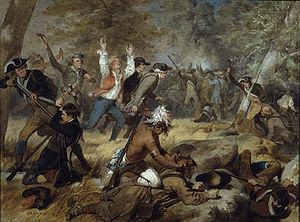Trial of Evan Morgan
By Mark Relation, DLAR Intern
This is my last week with the David Library, and so this will be my final post. For my final entry, I have chosen to write about one of the other projects that I have been working on this summer: reading and indexing British courts martial from the mid 1700’s. This is particularly interesting work, as many of the soldiers on trial get themselves into downright humorous situations that could rival any that appear on courtroom TV shows. Below is a summary of the trial of Private Evan Morgan, one of my personal favorite cases that I read this summer.
On October 13, 1748, a general court martial was held in Berwick to hear the case of Pvt. Morgan, accused of desertion and joining the enemy. A few witnesses were called testifying that he had in fact left the unit and was not seen again by them until the trial. Morgan then got the chance to give his version of events.
In August, 1745, Morgan’s unit was travelling in a bilander (merchant ship with two masts), which had stopped for a time. Several men, Morgan included, left the ship to go to a pub and have a few drinks before the ship moved on again. However, the pub was very crowded and Morgan was unable to get himself a drink before the ship was preparing to leave. His companions told him it was time to leave, but Morgan elected to stay and have his drink and spent the night at the pub instead of the crowed vessel.
After a presumably eventful night (he only reported getting a half hour of sleep at the pub), Morgan awoke to find that the bilander had already moved on without him. Morgan set out after his unit, but was apprehended by four Dutch-speaking men who took his hat and coat and took him back to their guard house. They placed him before an officer who tried to recruit him for service in France. Not wanting to enlist for foreign service, Morgan proceeded to talk and connive his way out and return to his home unit.
Morgan was able to get the commanding officer drunk and then convinced the others that he had enlisted without actually doing so. He joined a different unit, and marched with them to winter quarters, where he and four other men plotted to make their escape. This did not go as planned, however, as when the group was escaping, they made it to a river only to remember that two of them could not swim, Morgan included. Morgan was recaptured, and sent to prison on and off until his trial in 1748, three years after the fateful night at the pub.
Morgan was found guilty of desertion and joining the enemy under the 10th Article of War and sentenced to receive 1,000 lashes (not uncommon for desertion charges). When the case was later sent to the king for confirmation, Morgan was pardoned, and continued to serve with the British military.
WO71/39 p. 20-25
I hope you have enjoyed following the blog this summer. For more information about every topic covered here and more, please feel free to come to the David Library of the American Revolution.
I hope you have enjoyed following the blog this summer. For more information about every topic covered here and more, please feel free to come to the David Library of the American Revolution.













